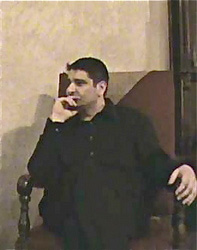
|  |  |  Entertainment | Books Entertainment | Books  
The Passion of the Baptist, not the Christ?
 PVNN PVNN
May 15, 2010


| | Agron Belica says: “John the Baptist has been misrepresented by scholars of both Christianity and Islam” |  |
Recent research embodied in a new book by Agron Belica invites our attention to the predicament of John the Baptist, popularly known for little more than the story of his beheading by order of Herod Antipas at the behest of a seductive dancing girl, the infamous Salome.

His book, The Crucifixion: Mistaken Identity? John the Baptist and Jesus the Christ, arguing from the chronological and historical evidence provided by the ancient Jewish historian Josephus and the New Testament about John, demonstrates that the story of his beheading is almost certainly spurious.

“Countless works have been published pertaining to the false crucifixion of the son of Mary by Muslims, yet the false beheading of the son of Zachariah is largely ignored, why?”

Comparison with the writings of Josephus gives the lie to this scenario for, as the detailed scrutiny and evaluation of Josephus’s text shows, Herod Antipas probably did not order John’s execution until 36 CE, half a dozen years later than most datings of the event of the crucifixion. Belica suggests that it was the Prophet Yahya (John the Baptist) who was placed on the cross and survived the ordeal and not Jesus, in a case of mistaken identity.

The book’s editor, Dr. Jay R. Crook, asks: “How would this later date affect our discussion of Belica’s theories, especially his suggestion that John was the principal actor in the crucifixion, not Jesus? Put simply, it would remove it from the realm of chronological impossibility to that of chronological possibility.” It would relegate the colorful John-Salome story (to which Josephus makes no reference) to the category of an urban myth, not history.

Step by step, his book carefully and plausibly resurrects the reputation of the Baptist, not as a minor gospel figure, the forerunner of Christ, but as a major prophet in his own right. In an article published in 2008, The Revival of the Prophet Yahya, he noted that the Quran, while not slighting Jesus, accords Yahya (John the Baptist) such a status, citing key words in the Quranic text such as sayyid (chief), hasur (concealer of secrets), and waliy (protector/guardian). He contended that these words, among others, have been misinterpreted by most translators and commentators of the Quran, the result being that they have failed to confirm his unique status and his role in the messianic story.

Belica further criticizes those traditionalists who, he asserts, have fallen under the spell of the sensational Biblical account of John’s death and have repeated it in their commentaries without questioning its authenticity, even though there is nothing in the Quran to justify such a thing; indeed, Belica believes, the story goes against the entire tenor of the Quranic view of the prophet. He writes: “Countless works have been published pertaining to the false crucifixion of the son of Mary by Muslims, yet the false beheading of the son of Zachariah is largely ignored, why?”

Furthermore, Belica asserts: “The Prophet Yahya could not have been beheaded as has been asserted by many Muslim and Christian scholars. With regard to Jesus, in the Quran, we read: Peace be upon me the day I was born, the day that I die, and the day I will be raised up again. (Q. 19:33) The verse states that Jesus was given safety and security in these three situations. But what about the Prophet Yahya? We find the same description for him as we find for Jesus, Peace be upon him the day he is born, the day he dies, and the day he is raised up again. (Q. 19:15) How does the supposed beheading of Yahya fit in the above Quranic verse of one given peace by his Lord? As far as we know, all the prophets mentioned by name in the Quran were delivered from their enemies. Yet, the Prophet Yahya, whose name ironically means He Who Lives, is popularly believed to have been put to death. In my opinion, this would cause an inconsistency in the Quran.” said Belica.

Belica takes on another issue that has exercised Quranic exegetes over the centuries: the meaning and implications of the word shubbiha used in reference to the Crucifixion. The Quran explicitly denies the crucifixion of Jesus, instead declaring that it only appeared so unto them. Taking the issue forward from that, Belica discusses the relations of Jesus and John and the nature of their missions. Belica shows how the meaning of shubbiha in the Quran could extend to the resemblance of the two prophets John and Jesus and other places as well. “John’s being put on the cross would in no way impugn the peace of God as given to other prophets, such as Abraham who was given the same peace when thrown into the blazing fire, yet rescued by the Almighty.” said Belica.

Dr. Mahmoud Ayoub, Professor of Islamic Studies and Comparative Religion at the Hartford Seminary, in his comments about Agron Belica’s book, writes: “[It is an engaging analysis of the life and mission of the two kindred religious personages, John the Baptist (Yahya) and Jesus (‘Isa).”

Belica feels the whole role of the Prophet Yahya (John the Baptist) in religious history should be reevaluated. He considers him the most neglected of the major prophets and that it is time to redress this slight.

Book available at, The Harvard Book Store: harvard.com |

 |
|  |



